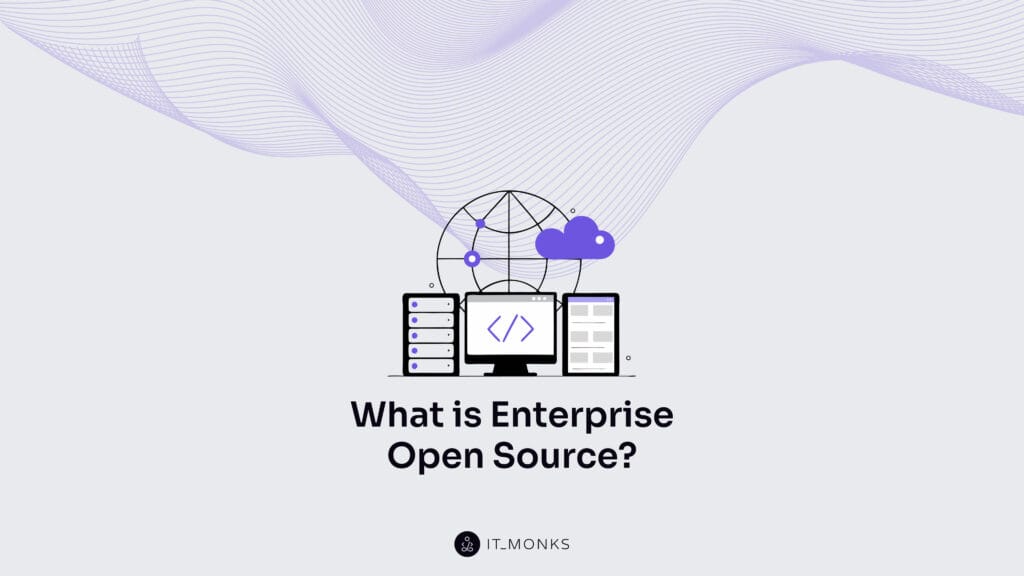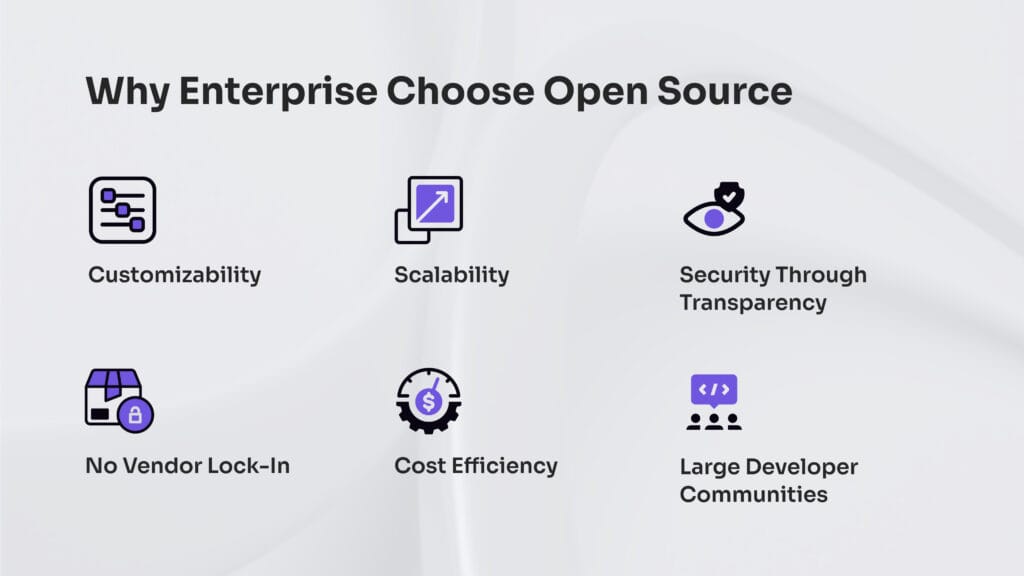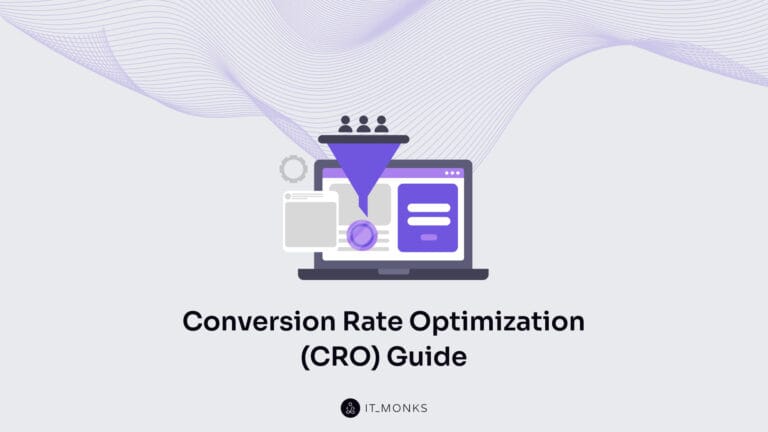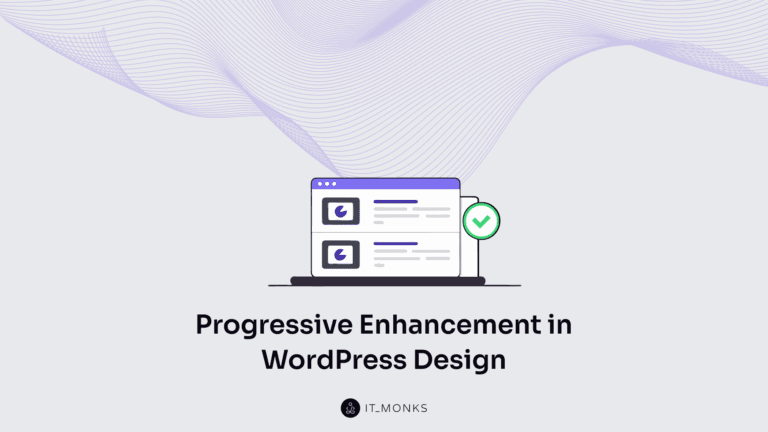Open Source for Enterprise
Table of Contents

Open source for enterprise refers to using software solutions whose source code is publicly available and can be modified, enhanced, and redistributed, tailored specifically to meet the complex demands of large organizations.
According to Red Hat’s 2023 State of Enterprise Open Source report, 82% of IT leaders use enterprise open source software for operations, infrastructure modernization, and application development.
Major players like Google, Netflix, and Facebook build and run large parts of their systems on open-source technologies, while companies such as Red Hat, Elastic, and Canonical have built entire business models around supporting and evolving open source in the enterprise.
There are several reasons why enterprise environments increasingly turn to open source.
It offers customization at scale, enabling organizations to tailor solutions to complex, evolving needs without waiting on vendor updates. With its transparent codebases, open source also strengthens security by allowing internal teams and the broader community to spot and fix vulnerabilities faster. And perhaps most crucially, it helps enterprises avoid vendor lock-in, giving them full control over their technology stack and the freedom to switch tools or providers without contractual friction.
A standout example is WordPress, one of the world’s most popular and high-quality open source enterprise solutions. It powers over 43% of all websites globally and is trusted by enterprises like Microsoft News and Sony Music for its flexibility, scalability, and strong community support.
What are the Reasons an Enterprise Should Choose Open Source?
There are several compelling reasons why organizations at an enterprise scale are embracing open source enterprise software, including its customizability, scalability, enhanced transparency and security, vendor neutrality, and community-driven innovation.

Customizability
Customizability is a key reason for enterprises to use open-source software, enabling organizations to modify, extend, and tailor applications to meet specific business requirements.
For organizations in highly specialized industries (like finance, healthcare, or telecom) off-the-shelf solutions often lack the precision or compliance required. With open source, teams can build systems that align exactly with their workflows, security protocols, and performance goals.
Take Netflix, for example. The company depends heavily on open-source technologies and customizes tools like Apache Kafka and Spinnaker to manage its complex infrastructure efficiently. Their ability to adjust tools internally helps them scale rapidly and maintain high availability, something that would be difficult or costly with proprietary alternatives.
Customizability also accelerates innovation cycles. Instead of waiting for external vendors to push updates or new features, in-house teams can implement changes immediately, fixing bugs, enhancing functionality, or integrating new capabilities.
WordPress, one of the most popular open-source enterprise platforms, illustrates this perfectly. Its vast plugin ecosystem and developer-friendly architecture make it a favorite among enterprises like The New York Times and Microsoft, which use it to power everything from newsrooms to intranet portals.
Scalability
Scalability is a system’s ability to handle increasing workloads (whether that means more users, higher traffic, larger datasets, or more complex processes) without a drop in performance or the need to completely overhaul the infrastructure. As business needs evolve, scalable open-source solutions allow organizations to adapt efficiently.
According to Red Hat’s 2024 report, 75% of enterprises believe open source offers superior scalability compared to proprietary solutions.
Developed and improved by global communities facing a wide variety of challenges, open-source enterprise software is designed to flex and grow. Its modular and decoupled nature allows enterprises to scale specific components (such as services, databases, or APIs) independently, providing greater control and efficiency.
A prominent example is Kubernetes, an open-source container orchestration platform originally created by Google. Now managed by the Cloud Native Computing Foundation, Kubernetes powers scalable environments for companies like Spotify, Shopify, and Airbnb, enabling them to serve millions of users globally with speed and reliability.
What further sets open source apart is its natural compatibility with cloud-native infrastructure. Cloud providers like AWS, Google Cloud, and Azure not only support open-source technologies but actively incorporate them into their core services, demonstrating how open source is deeply embedded in enterprise-scale operations.
Security Through Transparency
Security through transparency refers to the principle that openly accessible code invites constant peer review, enabling faster identification and resolution of vulnerabilities. This process, often enhanced through practices like Software Composition Analysis (SCA), makes it easier to detect flaws, apply fixes quickly, and ensure ongoing code integrity.
When thousands of developers and security researchers around the world can review the same software, issues are often found and resolved faster than they would be within a closed vendor team. This is why companies like IBM, Intel, and even the U.S. Department of Defense actively support open source enterprise initiatives. They recognize that open code equals greater accountability and trust.
Linux, one of the most widely used enterprise open source solutions, powers everything from Android phones to the servers behind Google and Amazon. Its widespread adoption isn’t just because it’s free. It’s because it’s secure and thoroughly vetted.
A GitHub report found that open source projects have a median time-to-fix for vulnerabilities of just 19 days, often much faster than proprietary counterparts. For businesses concerned with compliance, data privacy, and cyber threats, this kind of responsiveness is crucial.
No Vendor Lock-In
No vendor lock-in means organizations retain full control over their technology choices without being confined to a single provider’s ecosystem, pricing, or roadmap. Open source empowers enterprises to adopt, customize, and migrate their systems as needed, on their own terms.
With access to the source code, companies can build internal expertise, switch support providers, or scale infrastructure without disruption or costly transitions.
For example, Deutsche Bank has adopted open source enterprise tools to reduce reliance on proprietary financial software, gaining both cost efficiency and the freedom to innovate more quickly.
This kind of independence is especially valuable for mission-critical systems, where delays or limitations imposed by a single vendor can be risky. Open source eliminates those dependencies by offering transparent, portable, and community-driven solutions.
According to a 2023 Gartner study, 70% of CIOs cite vendor independence as a key reason for adopting enterprise open source. Tools like WordPress exemplify this advantage. It powers over 43% of the web and allows full control over hosting, customization, and development partnerships, free from vendor-imposed constraints.
Cost Efficiency
Cost efficiency refers to the ability to significantly reduce software-related expenses (such as licensing, deployment, and maintenance costs) while maintaining flexibility, scalability, and high performance.
Since open-source solutions are typically free to use, organizations can allocate their budgets towards innovation, custom development, or other critical business areas instead of paying for expensive software licenses.
Large enterprises, such as NASA and eBay, have long relied on open source solutions to keep their infrastructure costs in check while still maintaining world-class performance and scalability. NASA, for example, uses open source tools to manage data and facilitate complex computations, ensuring that their operations remain cost-effective while still achieving cutting-edge results.
A study by The Linux Foundation found that open source users experience up to 70% savings on IT infrastructure costs over proprietary alternatives.
The cost benefits of open enterprise solutions are particularly noticeable when compared to proprietary software that often comes with hidden costs for maintenance, upgrades, and scaling. By using open source software, businesses can better control their total cost of ownership and avoid the hefty expenses that come with vendor lock-ins and inflexible licensing.
Large Developer Communities
Large developer communities represent dynamic, global networks of developers who actively contribute to, maintain, and evolve open-source projects tailored to specific industries or business needs. These communities are driven by a shared interest in improving and enhancing particular software platforms, and their collective knowledge and efforts result in continuous innovation and faster issue resolution.
For enterprises, the presence of large developer communities ensures that issues are identified and resolved quickly. When a problem arises, there’s an entire network of contributors to help solve it, rather than waiting for vendor support, which can sometimes take days or even weeks.
A study by GitHub found that open source projects with large, active communities are 25% more likely to release bug fixes and updates faster than proprietary solutions, which is a crucial factor for enterprises that rely on uptime and security.
WordPress exemplifies this benefit. With an enormous global community of contributors, WordPress enterprise experts can easily tap into this network for solutions, plugins, or customizations. This is why so many large organizations, including Time Inc. and Sony Music, choose WordPress for their enterprise needs.
Moreover, the large community ensures that open-source projects like WordPress, Linux, and Kubernetes have well-established documentation, educational resources, and third-party support available.
WordPress for Enterprise
WordPress offers a variety of benefits to enterprises, including scalability, customization, community-driven innovation, SEO optimization, and seamless integration with enterprise tools. Its open-source foundation has transformed it from a simple blogging tool into one of the most powerful and flexible content management systems (CMS) in the enterprise space.
According to a report by Evermade, 55% of enterprises now rely exclusively on WordPress for their CMS needs (a 17% increase since 2024). While exact figures vary, MageComp estimates that WordPress powers over 1.5 million active enterprise-level users globally.
Data from W3Techs shows that 62% of businesses searching for CMS solutions choose WordPress for its ability to support diverse use cases, from e-commerce platforms and content-heavy media sites to complex multi-site networks. Major organizations such as The Walt Disney Company, Microsoft News, and Time Inc. depend on WordPress to manage high-traffic environments and complex integrations.
Its vast plugin ecosystem (with over 59,000 free plugins available in the WordPress Plugin Directory) and expansive library of themes enable deep customization, while extensive community support ensures access to development resources, security updates, and expert guidance.
Despite common security challenges, the platform’s transparency and open-source nature mean vulnerabilities are quickly addressed by the global developer community. With the right security best practices in place, WordPress remains a robust and secure choice for enterprises.
WordPress’s open-source nature gives enterprises full control over customization. Organizations can modify the codebase to meet specific business requirements, add features, enhance security, and integrate with other enterprise systems.
Organizations using WordPress report measurable business outcomes, including improved website traffic, lead generation, and RO. For example, Tethys Energy saw a 37% increase in qualified leads and 157% growth in organic traffic, while Insight Northwest Recovery experienced a 276% rise in calls from organic search.
WordPress seamlessly integrates with numerous third-party enterprise tools, such as CRM systems (e.g., Salesforce) and marketing automation platforms (e.g., HubSpot). This interoperability allows businesses to unify their workflows and improve cross-departmental collaboration, making WordPress an indispensable tool for enterprises looking to streamline operations and drive efficiency.
WordPress’s popularity spans sectors like education, non-profit, and enterprise e-commerce, making it a versatile and future-ready solution backed by a strong ecosystem and community.
Contact
Don't like forms?
Shoot us an email at [email protected]

Send a Project Brief
You need to load content from reCAPTCHA to submit the form. Please note that doing so will share data with third-party providers.
More InformationYou are currently viewing a placeholder content from Turnstile. To access the actual content, click the button below. Please note that doing so will share data with third-party providers.
More InformationYou are currently viewing a placeholder content from Facebook. To access the actual content, click the button below. Please note that doing so will share data with third-party providers.
More InformationYou are currently viewing a placeholder content from Instagram. To access the actual content, click the button below. Please note that doing so will share data with third-party providers.
More InformationYou are currently viewing a placeholder content from X. To access the actual content, click the button below. Please note that doing so will share data with third-party providers.
More Information


